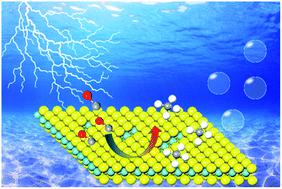当前位置:
X-MOL 学术
›
Sustain. Energy Fuels
›
论文详情
Our official English website, www.x-mol.net, welcomes your
feedback! (Note: you will need to create a separate account there.)
Vacancy-induced high activity of MoS2 monolayers for CO electroreduction: a computational study
Sustainable Energy & Fuels ( IF 5.0 ) Pub Date : 2021-08-18 , DOI: 10.1039/d1se00988e Dongxu Jiao 1 , Yu Tian 2 , Yuejie Liu 3 , Qinghai Cai 1, 3, 4 , Jingxiang Zhao 1
Sustainable Energy & Fuels ( IF 5.0 ) Pub Date : 2021-08-18 , DOI: 10.1039/d1se00988e Dongxu Jiao 1 , Yu Tian 2 , Yuejie Liu 3 , Qinghai Cai 1, 3, 4 , Jingxiang Zhao 1
Affiliation

|
The electroreduction of CO (COER) to valuable carbon-based chemicals is an attractive alternative to the traditional Fischer–Tropsch process, in which the development of electrocatalysts with high activity and high selectivity still remains a huge challenge. Herein, by means of density functional theory (DFT) computations, we systematically explored the potential of defective MoS2 monolayers with sulfur vacancies, including mono-sulfur (VS), di-sulfur (VS2 and V2S), and tri-sulfur (V3S), as COER electrocatalysts. Our results revealed that these defective MoS2-based candidates exhibit low formation energies and high stability, holding great promise for experimental synthesis and practical applications. In particular, according to the computed free energy changes, we found that the catalytic activity of these considered defective MoS2 monolayers for COER is highly dependent on the size of sulfur vacancies in MoS2 monolayers, among which V3S exhibits the best COER catalytic performance, and CH4 is identified as the main product. Interestingly, the difference between the adsorption strength of *CH2 and *CH3 species can be used as a rational descriptor to evaluate the COER catalytic activity of these defective MoS2 monolayers. Thus, controlling the size of S-vacancies can make MoS2 monolayers a promising electrocatalyst for COER, which not only further widens the potential of MoS2 monolayers in electrocatalysis, but also opens a new door for CO reduction for renewable energy supply.
中文翻译:

空位诱导的 MoS2 单层高活性 CO 电还原:一项计算研究
将 CO(COER)电还原为有价值的碳基化学品是传统 Fischer-Tropsch 过程的一种有吸引力的替代方法,在该过程中,开发具有高活性和高选择性的电催化剂仍然是一个巨大的挑战。在此,通过密度泛函理论 (DFT) 计算,我们系统地探索了具有硫空位的缺陷 MoS 2单分子层的潜力,包括单硫 (V S )、二硫 (V S2和 V 2S ) 和三-硫 (V 3S ),作为 COER 电催化剂。我们的结果表明这些有缺陷的 MoS 2基于的候选物表现出低形成能和高稳定性,在实验合成和实际应用中具有广阔的前景。特别是,根据计算的自由能变化,我们发现这些被认为有缺陷的 MoS 2单层对 COER的催化活性高度依赖于 MoS 2单层中硫空位的大小,其中 V 3S表现出最好的 COER 催化性能,CH 4被确定为主要产品。有趣的是,*CH 2和*CH 3物种的吸附强度之间的差异可以用作评估这些有缺陷的 MoS 2的 COER 催化活性的合理描述符单层。因此,控制S空位的大小可以使MoS 2单层成为COER的有前途的电催化剂,这不仅进一步拓宽了MoS 2单层在电催化中的潜力,而且为可再生能源供应的CO还原打开了新的大门。
更新日期:2021-09-01
中文翻译:

空位诱导的 MoS2 单层高活性 CO 电还原:一项计算研究
将 CO(COER)电还原为有价值的碳基化学品是传统 Fischer-Tropsch 过程的一种有吸引力的替代方法,在该过程中,开发具有高活性和高选择性的电催化剂仍然是一个巨大的挑战。在此,通过密度泛函理论 (DFT) 计算,我们系统地探索了具有硫空位的缺陷 MoS 2单分子层的潜力,包括单硫 (V S )、二硫 (V S2和 V 2S ) 和三-硫 (V 3S ),作为 COER 电催化剂。我们的结果表明这些有缺陷的 MoS 2基于的候选物表现出低形成能和高稳定性,在实验合成和实际应用中具有广阔的前景。特别是,根据计算的自由能变化,我们发现这些被认为有缺陷的 MoS 2单层对 COER的催化活性高度依赖于 MoS 2单层中硫空位的大小,其中 V 3S表现出最好的 COER 催化性能,CH 4被确定为主要产品。有趣的是,*CH 2和*CH 3物种的吸附强度之间的差异可以用作评估这些有缺陷的 MoS 2的 COER 催化活性的合理描述符单层。因此,控制S空位的大小可以使MoS 2单层成为COER的有前途的电催化剂,这不仅进一步拓宽了MoS 2单层在电催化中的潜力,而且为可再生能源供应的CO还原打开了新的大门。









































 京公网安备 11010802027423号
京公网安备 11010802027423号